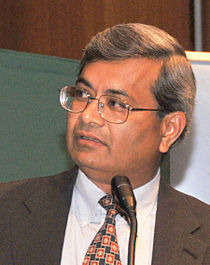Bhanu Pratap Jena
This article has an unclear citation style. (February 2021) |
Bhanu Pratap Jena | |
|---|---|
 Jena in 2012 | |
| Born | 1 November 1955 Jajpur, Odisha, India |
| Nationality | American |
| Alma mater | BJB College, Utkal University, Iowa State University |
| Known for | Porosome, Membrane fusion |
| Awards |
|
| Scientific career | |
| Fields | Chemistry, cell biology |
Bhanu Pratap Jena (born November 1, 1955) is an American cell biologist and the "George E. Palade University Professor and Distinguished Professor of Physiology" at the Wayne State University School of Medicine, who discovered porosome in mid 1990s & demonstrated it to be the universal secretory machinery in Plasma Membrane.[1][2][3][4][5]
Biography[edit]
Jena was born in Jajpur, Odisha, India on November 1, 1955, to Manju and Prafulla Jena.[citation needed]
He majored in Chemistry, Zoology and Botany from BJB College (B.Sc.,1975) and studied Zoology (Endocrinology) at Utkal University (M.Sc.,1978).[citation needed] Following four years of lectureship at various colleges in Utkal University (1978–82), he received a teaching and research fellowship from Iowa State University in 1982 to pursue studies leading to a doctorate degree.[citation needed] In December 1988, he received his PhD in Zoology (Molecular Endocrinology) from Iowa State.[6] Followed by postdoctoral studies at Iowa State and Yale Universities (1988–1994), he joined Yale University as an Assistant Professor, and in 2000, joined as Professor in the Department of Physiology, at Wayne State University School of Medicine.[7][better source needed]
Scientific career[edit]
Using Atomic force microscope on live cells, Jena was the first to report the discovery of a new cellular structure the Porosome in the mid 1990s. The Porosome are permanent supramolecular structures at the cell Plasma membrane, where secretory Vesicle (biology and chemistry) dock and fuse to release intravesicular contents to the outside of the cell. This discovery was a major breakthrough in our understanding of cell secretion. The Porosome, has been determined as the universal secretory machinery in cells, from exocrine cells of the pancreas, to neuroendocrine cells, and neurons. Jena and his research team has determined the structure and dynamics of the Porosome in live cells, at nm resolution and in real time. The structure of the Porosome was further confirmed by electron microscopy in whole cells, and in isolated Porosome preparations. The isolated Porosome has been both structurally and functionally reconstituted in lipid membrane and live cells, and its composition determined. The discovery of the Porosome, and an understanding of its structure, function, composition, and reconstitution, has opened a new field in cell biology; nano cell biology[3].
References[edit]
- ^ Horber, J. K. H. and Miles, M. J. (2003) Scanning Probe Evolution in Biology. Science, 302:1002-1005.
- ^ Singer, M.V. (2004). Legacy of a Distinguished Scientist: George E. Palade. Pancreatology, 3:518-519.
- ^ Editorial (2006) Tribute to Professor Bhanu P. Jena. J. Cell Mol. Med, 10:270.
- ^ Trikha, S., Lee, E.C., Jeremic, A.M. (2010). Cell Secretion: Current Structural and Biochemical Insights. TheScientificWorld Journal 10:2054-2069.
- ^ Jeftinija, S. The story of cell secretion: events leading to the discovery of the 'Porosome' -the universal secretory machinery in cells. J. Cell Mol. Med. 10(2):273-279.
- ^ "Discoveries Interview: Professor Bhanu P. Jena on the discovery of the porosome, the universal machinery for cellular secretion". Discoveries. 2 (3): e28. 2014. doi:10.15190/d.2014.20. ISSN 2359-7232. PMC 6941552. PMID 32309555.
- ^ "Biography" (PDF). Archived from the original (PDF) on 2011-05-26.
